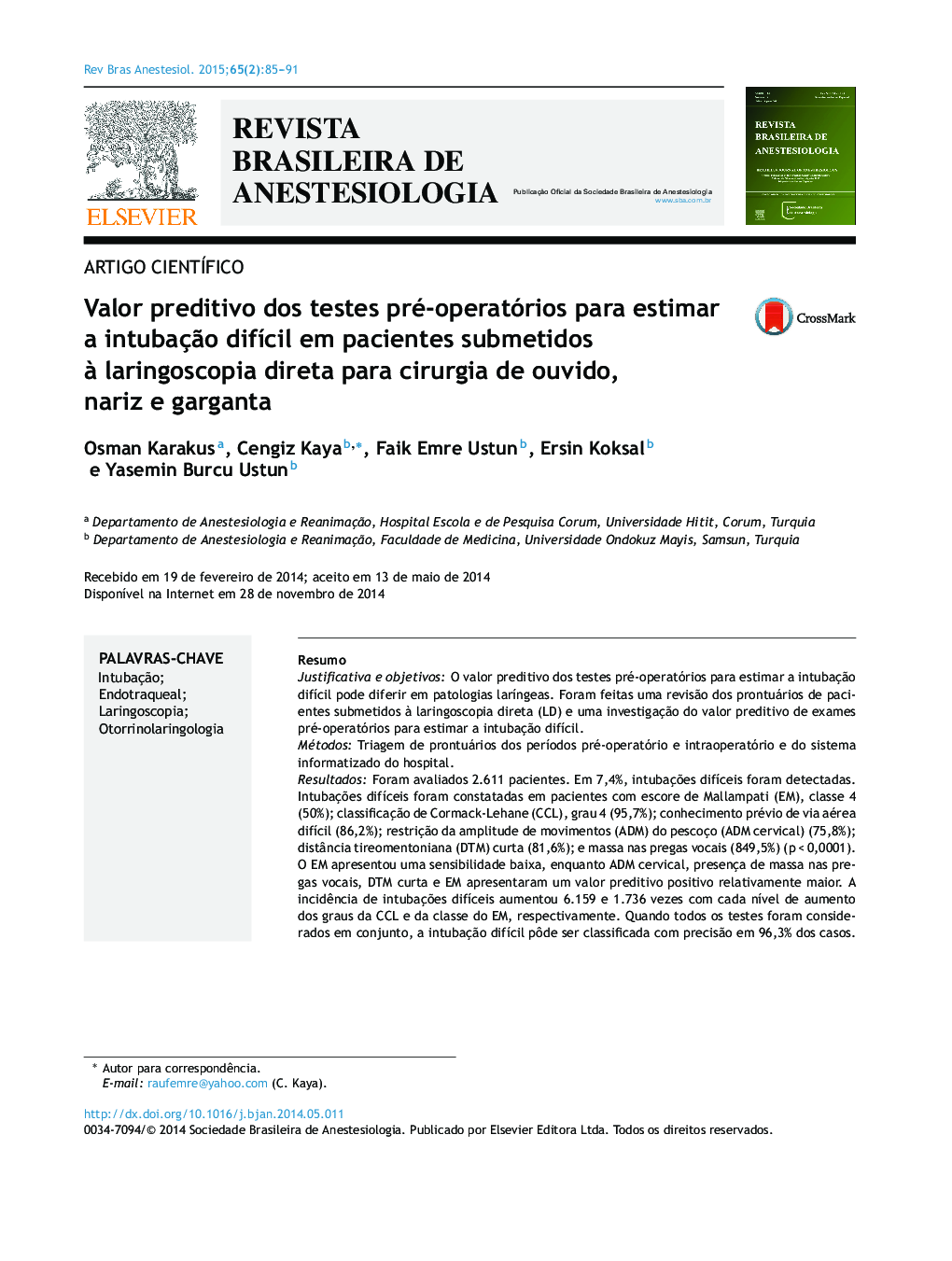| کد مقاله | کد نشریه | سال انتشار | مقاله انگلیسی | نسخه تمام متن |
|---|---|---|---|---|
| 2749360 | 1567231 | 2015 | 7 صفحه PDF | دانلود رایگان |

ResumoJustificativa e objetivosO valor preditivo dos testes pré‐operatórios para estimar a intubação difícil pode diferir em patologias laríngeas. Foram feitas uma revisão dos prontuários de pacientes submetidos à laringoscopia direta (LD) e uma investigação do valor preditivo de exames pré‐operatórios para estimar a intubação difícil.MétodosTriagem de prontuários dos períodos pré‐operatório e intraoperatório e do sistema informatizado do hospital.ResultadosForam avaliados 2.611 pacientes. Em 7,4%, intubações difíceis foram detectadas. Intubações difíceis foram constatadas em pacientes com escore de Mallampati (EM), classe 4 (50%); classificação de Cormack‐Lehane (CCL), grau 4 (95,7%); conhecimento prévio de via aérea difícil (86,2%); restrição da amplitude de movimentos (ADM) do pescoço (ADM cervical) (75,8%); distância tireomentoniana (DTM) curta (81,6%); e massa nas pregas vocais (849,5%) (p < 0,0001). O EM apresentou uma sensibilidade baixa, enquanto ADM cervical, presença de massa nas pregas vocais, DTM curta e EM apresentaram um valor preditivo positivo relativamente maior. A incidência de intubações difíceis aumentou 6.159 e 1.736 vezes com cada nível de aumento dos graus da CCL e da classe do EM, respectivamente. Quando todos os testes foram considerados em conjunto, a intubação difícil pôde ser classificada com precisão em 96,3% dos casos.ConclusãoOs resultados dos testes que preveem intubações difíceis em casos com LD coincidiram claramente com os resultados previstos na literatura para as populações de pacientes em geral. As diferenças em alguns resultados dos testes, quando comparados com os da população em geral, podem ser por causa das condições patológicas subjacentes da laringe em populações de pacientes com intubação difícil.
Background and objectivesPredictive value of preoperative tests in estimating difficult intubation may differ in the laryngeal pathologies. Patients who had undergone direct laryngoscopy (DL) were reviewed, and predictive value of preoperative tests in estimating difficult intubation was investigated.MethodsPreoperative, and intraoperative anesthesia record forms, and computerized system of the hospital were screened.ResultsA total of 2611 patients were assessed. In 7.4% of the patients, difficult intubations were detected. Difficult intubations were encountered in some of the patients with Mallampati scoring (MS) system Class 4 (50%), Cormack–Lehane classification (CLS) Grade 4 (95.7%), previous knowledge of difficult airway (86.2%), restricted neck movements (cervical ROM) (75.8%), short thyromental distance (TMD) (81.6%), vocal cord mass (49.5%) as indicated in parentheses (p < 0.0001). MS had a low sensitivity, while restricted cervical ROM, presence of a vocal cord mass, short thyromental distance, and MS each had a relatively higher positive predictive value. Incidence of difficult intubations increased 6.159 and 1.736‐fold with each level of increase in CLS grade and MS class, respectively. When all tests were considered in combination difficult intubation could be classified accurately in 96.3% of the cases.ConclusionTest results predicting difficult intubations in cases with DL had observedly overlapped with the results provided in the literature for the patient populations in general. Differences in some test results when compared with those of the general population might stem from the concomitant underlying laryngeal pathological conditions in patient populations with difficult intubation.
Journal: Brazilian Journal of Anesthesiology - Volume 65, Issue 2, March–April 2015, Pages 85–91